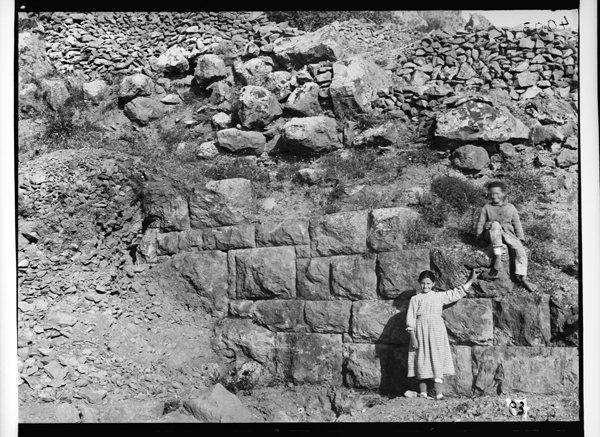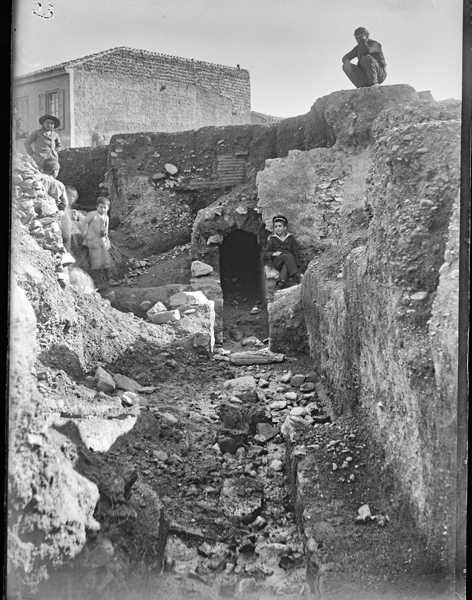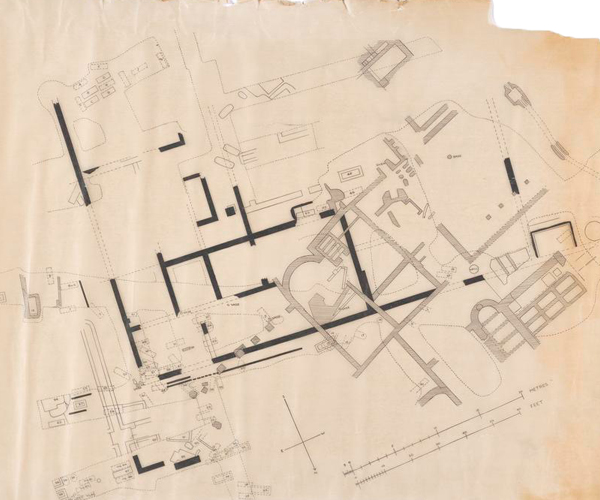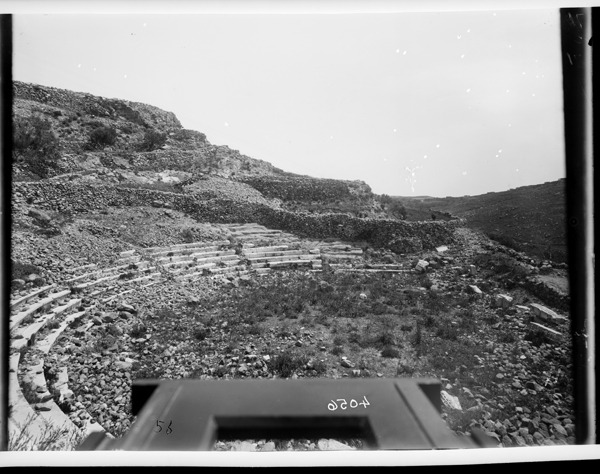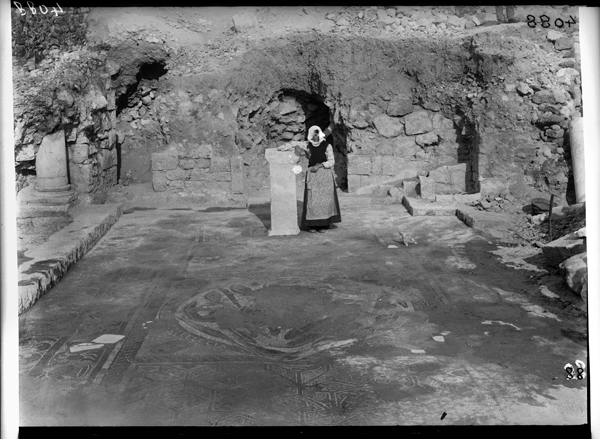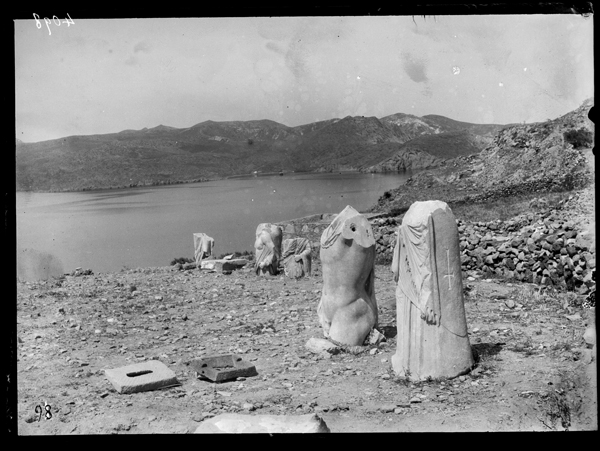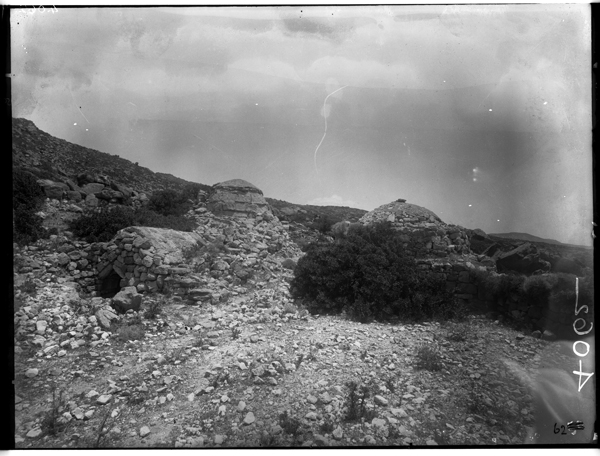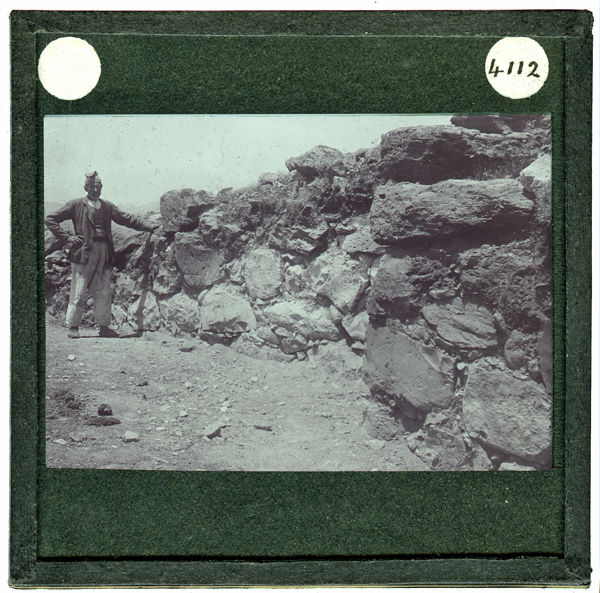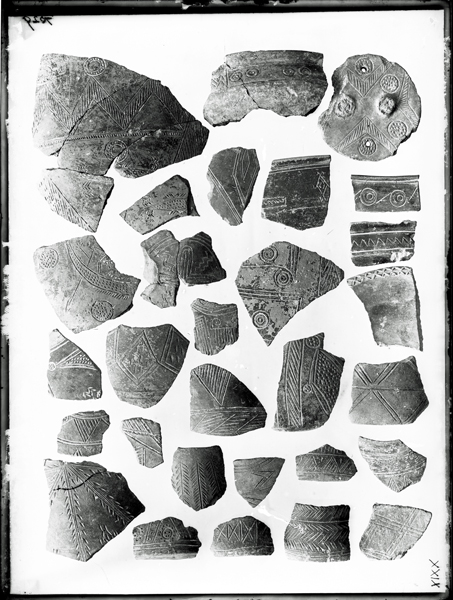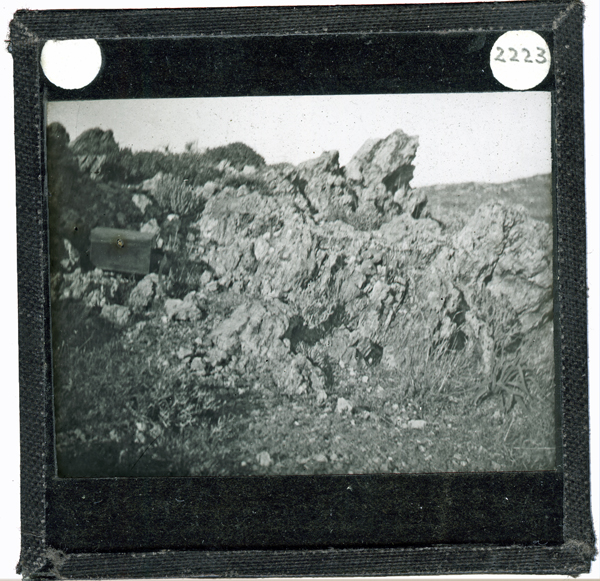Digging II: 19th-century Kynosarges and the Melos Campaign in the BSA SPHS Image Collection
In its earliest years, financial constraints on the British School at Athens made it problematic to mount large-scale excavations. This is chronicled in the previous Archive Story, Digging I: the earliest 19th-century BSA Excavations in the BSA SPHS Image Collection. However, by 1896, the first government grant of £500 per annum (for five years) made it possible to plan more ambitious projects. The Melos Campaign 1896-1899 was a direct beneficiary of this increased financial support.
But, before we discuss Melos, we need to look at the BSA’s small Athens-based excavation at Kynosarges 1896-1897 which was conducted at the same time as the start of the Melos Campaign. The timing was no coincidence. In the Annual Reports, the excavation at Kynosarges is referred to as ‘preliminary’. In effect, it served as a training excavation, close to the premises of the BSA, in preparation for work on Melos. The site, to the south-west of the Olympieion, on the south bank of the Ilissos River, was chosen since it was likely to be the place where a large public gymnasium and a shrine to Heracles was located. The excavations revealed traces of the gymnasium overlaid by a large Roman bath house along with earlier (6th-5th c. B.C.) burials below the foundations. Although there were some published accounts of the excavations in The Journal of Hellenic Studies (JHS) and the newly established Annual of the British School at Athens (ABSA), they focused on architectural elements and pottery. The site was never comprehensively published.
The excavations at Kynosarges were funded privately by Mr. C. W. Mitchell and an anonymous friend of the BSA. It was carried out under the direction of the newly appointed BSA Director Cecil Smith and BSA student R.C. Bosanquet with the expert assistance of Theodore Bent and the BSA’s architect, Charles Clark. Notebooks, unpublished plans and some ephemera are located in the Kynosarges Excavation Records of the BSA archive. In addition, there are a few photographs from the BSA SPHS Image collection.
The main focus at this time, however, was the Melos Campaign. According to the BSA financial records, the campaign was the most expensive excavation programme up to date – over £700 for four years. It was an extensive programme of exploration of the island that consisted of various excavations including those at Tramythia (1896-1897), Pelos (1897) and Phylakopi (1896-1899) along with an island-wide survey (1896). It was initiated by Cecil Smith, but handed over to the next director, D.G. Hogarth after the second season in 1897. The bulk of the actual work, however, fell to BSA student Duncan Mackenzie.
Scant archival evidence exists for the Melos Campaign. One of the Kynosarges excavation notebooks (dated 1896) also contains information about Melos and may have belonged to Cecil Smith. It contains information about Tramythia, including transcriptions of several inscriptions. In addition, Hogarth’s Melos notebook (1898-1899) is located in his archive at Magdalen College, Oxford. The best evidence is from the published reports and the BSA SPHS Image Collection which contains numerous images of the excavations at Tramythia and Phylakopi. The descriptions of the photographs, for the most part, use the original historical captions supplied to the SPHS and may not reflect modern interpretations.
The Classical town of Tramythia or Klima, after the closest village to the site, was investigated during the first year (1896) and a small exploratory trench in the Demarch’s field was dug the following year. The site had been excavated in a piecemeal fashion by numerous private individuals in the past and many of its inscriptions had been studied. The BSA’s test trenches in various parts of the site were designed to clarify the history and layout of the city. The city gate, a stadium, a Roman theatre, a spectacular mosaic floored ‘Hall of the Mystae’ and early Byzantine churches were identified. However, according to Colin Renfrew in An Island Polity (1982), work at the site was abandoned due to the degree of clandestine excavations, the deep overlay of later deposits and the disturbance by agricultural terracing. The BSA turned its attention to other parts of the island.
After the first excavation season concluded, Duncan Mackenzie spent the summer of 1896 conducting an island-wide extensive survey. He proceeded to catalogue sites around the island, including the slightly submerged churches of Christos and the Panagia at Kepos shown in an image from the survey in the BSA SPHS collection. These churches were studied by H.M. Fletcher and S.D. Kitson during the first season on the island and were thought to be the oldest churches on the island.
When the excavations at Tramythia were abandoned, BSA activity focused on the prehistoric site of Phylakopi which showed more promise. In the first year, time constraints limited excavation at the site of Phylakopi to twelve days, but circuit walls were uncovered, described as similar to those at Tiryns which lead Smith to refer to Phylakopi as a ‘prehistoric fortress’. They also uncovered a large number of obsidian and flint artefacts as well as a quantity of ‘Mycenaean’ (i.e. Bronze Age) pottery.
Excavations continued here until 1899, but complications arose at the start of the second season. Cecil Smith remarks in the excavation report for 1897 that the war (i.e. the Greco-Turkish War of 1897) resulted in disrupted travel to and from the island and difficulties in acquiring a local workforce. In addition, at the beginning of 1897 the Greek Government initiated new laws regulating foreign excavation. The land now had to be purchased and all finds and eventually the land itself became property of the Greek state. Without the government grant, the BSA would have had to raise even more funds to carry out its research here or have been forced to halt operations.
While waiting for negotiations on the sale of various parcels of land on which the site of Phylakopi stood, Smith dispatched students to excavate smaller sites in other areas of the island. One of those sites was Pelos, south of Phylakopi which Mackenzie had identified in his survey. Here, Mackenzie noticed evidence of burials, but indicated that no trace of the associated settlement could be located. Campbell Cowan Edgar, a BSA student who would later go on to have a distinguished career as an Egyptologist, carried out the excavation after the purchase of the land from the local farmer. In Edgar’s report, he indicated that the area was strewn with pottery and many of the graves had been looted. The graves and associated finds were thought to be similar to the burials excavated by Theodore Bent on Antiparos (i.e. Early Cycladic), although at Pelos there were no marble or metal objects found like the ones illustrated below.
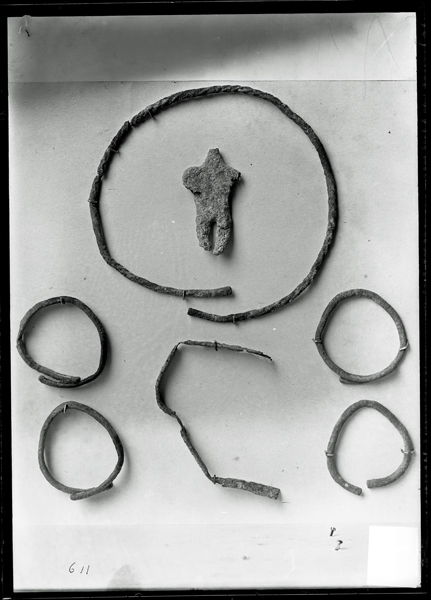
BSA SPHS 01/1644.4119. Prehistoric objects from Antiparos (now in the British Museum) excavated by Theodore Bent, illustrated in Edgar’s report on his excavations at Pelos.
Eventually some of the land on which Phylakopi sat was purchased so work could begin. However, fraught negotiations for a further parcel of land would continue into the next year. During the 1897-1899 seasons, successive settlements and nearby tombs were uncovered. Architecturally, one of the buildings was identified as a palace – a Mycenaean style megaron – and other structures sported frescos. Great quantities of pottery from the various levels provided a rich source of information. Some of the earliest pottery showed a similarity with the pottery found at Pelos and the later material contained Cretan imports as well as local imitations of Cretan pottery.
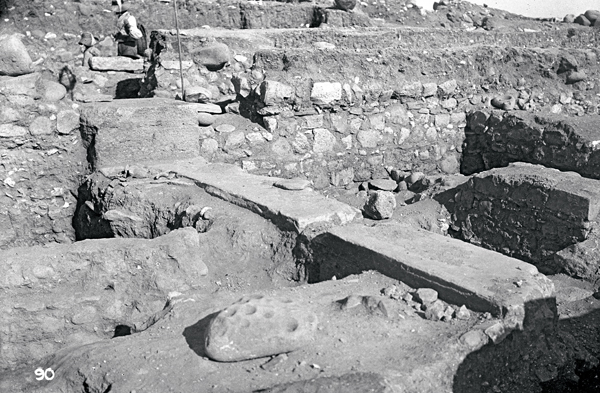
BSA SPHS 01/2251. 5917. Melos, Phylakopi: View of top step of portico and the plinth of anta of the palace
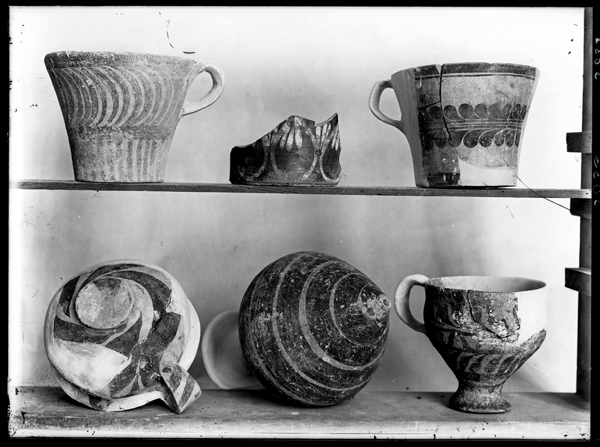
BSA SPHS 01/1950.5053. Melos, Phylakopi: Pottery, naturalistic pots, fine imported Kamares fragments
When D.G. Hogarth took over the directorship from Cecil Smith, he reported in 1898 that Phylakopi was a site of some significance, the first discovered in the islands that rivaled the great prehistoric towns of the mainland. Its main source of wealth was obsidian found in nearby quarries along the coast. Exports of obsidian and imports of foreign pottery demonstrated its network of connections. At the time of its publication in 1904 excavations at Phylakopi were considered to be at the forefront of research in the prehistoric Aegean.
In 1900, the BSA turned its sights to Crete since the change in the political situation (i.e. withdrawal of Ottoman control) opened new opportunities for excavation. Over a decade later, the BSA returned to Phylakopi for one season in 1911 under the directorship of R.M. Dawkins. As Dawkins remarks in his report on this later excavation at Phylakopi, the work in Crete and the mainland from 1900 onwards had revolutionised ideas about the Aegean Bronze Age necessitating a fresh look at new material from the significant site of Phylakopi. That, however, is another story.
Deborah Harlan
Honorary Research Fellow
Department of Archaeology
Sheffield University
The archives of Kynosarges Excavation and the Melos Campaign are now available on the BSA’s Digital Collections.
Click here for more BSA Archive Stories.
Further Reading:
| Kynosarges | |
| 1896/1897 | Rodeck, P. ‘The Ionic Capital of the Gymnasium of Kynosarges’ ABSA 3: 89-105 |
| 1897 | Edgar, C.E. [sic] ‘Two Stelae from Kynosarges’ JHS 17: 174-175 |
| 1905/1906 | Droop, J.P. ‘Dipylon Vases from the Kynosarges Site’, ABSA 12: 80-92 |
| Melos | |
| 1895/1896 | Smith, C. ‘Excavations in Melos’ ABSA 2: 63-76. |
| 1895/1896 | Bosanquet, R.C. ‘Excavations at Melos: The East Gate’ ABSA 2: 77-82. |
| 1896/1897 | Smith, C. ‘Excavations in Melos, 1897’ ABSA 3: 1-30. |
| 1896/1897 | Crawfoot, J.W. ‘Report of Tentative Excavations on the Demarch’s Field, Melos’ ABSA 3: 31-34. |
| 1896/1897 | Edgar, C.C. ‘Pre-Historic Tombs at Pelos’ ABSA 3: 35-51. |
| 1896/1897 | Mackenzie, D. ‘Ancient Sites in Melos’, ABSA 3:71-88. |
| 1896/1897 | Fletcher, H.M. and S.D. Kitson ‘The Churches of Melos’, ABSA 3:71-155-168. |
| 1897 | Smith, C. ‘Inscriptions from Melos’ JHS 17: 1-21. |
| 1897 | Mackenzie, D. ‘Excavations of the British School at Melos: The Site of the ‘Three Churches’ JHS 17: 122-133. |
| 1897/1898 | Hogarth, D.G., C.C. Edgar, D. Mackenzie ‘Excavations in Melos, 1898’ ABSA 4: 1-48. |
| 1898/1899 | Mackenzie, D., T.D. Atkinson, C.C. Edgar. ‘Excavations in Melos, 1899’ ABSA 5: 3-19. |
| 1898 | Bosanquet, R.C. ‘Excavations of the British School at Melos. The Hall of the Mystae’ JHS 18: 60-80. |
| 1898/1899 | Mackenzie, D., T.D. Atkinson, C.C. Edgar, ‘Excavations in Melos, 1899’ ABSA 5: 3-19. |
| 1904 | Atkinson, T.D. et al. Excavations at Phylakopi in Melos conducted by the British School at Athens. London: The Society for the Promotion of Hellenic Studies Supplementary Papers 4. |
| 1910/1911 | Dawkins, R.M. and J.P. Droop ‘Excavations at Phylakopi in Melos, 1911’ ABSA 17: 1-22. |
